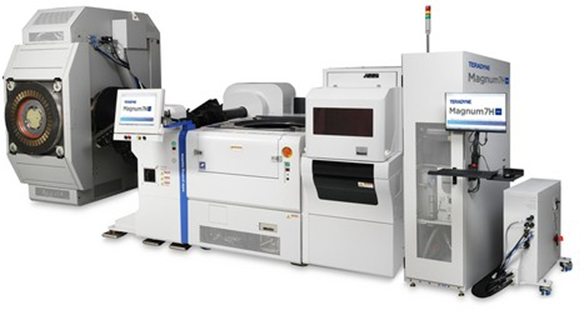Teradyne Introduces Next-Generation Memory Test Platform Magnum 7H for High-Bandwidth Memory (HBM) Chips
2025-08-08 14:57:19 1710
August 8, 2025, Beijing, China — Teradyne, a global leader in automated test equipment and robotics, announced the launch of its next-generation memory test platform, Magnum 7H, designed to meet the stringent testing requirements of high-bandwidth memory (HBM) chips integrated into GPUs and accelerators in high-performance generative AI servers. The Magnum 7H is specifically designed for large-scale HBM stacked die testing, featuring high parallel testing capability, high speed, and high precision. Leading HBM manufacturers have already begun using Teradyne's Magnum 7H platform for mass production testing and shipping of HBM chips, significantly boosting production capacity.

Figure. 1
Young Kim, President of Teradyne's Memory Test Division, stated, “We are proud to introduce the Magnum 7H, a revolutionary memory test platform that redefines the testing standards for HBM chips. This innovation marks a major breakthrough in memory test technology, not only meeting current chip testing needs but also preparing for future chip requirements.”
The Magnum 7H is an advanced memory testing platform supporting multiple generations of HBM chips, including HBM2E, HBM3, HBM3E, HBM4, and HBM4E. The platform provides comprehensive coverage from basic die wafer testing, memory core testing, to aging testing, ensuring the exceptional quality and reliability of HBM chips. Additionally, the Magnum 7H can be integrated with traditional probe stations and probe cards to test uncut HBM chips at the Known-Good-Stack-Die (KGSD) or Chip-on-Wafer (CoW) level, or it can be paired with new wafer probe stations/sorters to test cut HBM chips, thereby improving chip quality.
Teradyne Magnum 7H offers the following advantages:
Improved chip quality: Excellent DPS response time helps improve chip yield.
Comprehensive memory and logic testing: Magnum 7H is ideal for testing HBM stacks that include both logic base dies and DRAM dies. Among these, the flexible Algorithm Test Vector Generator (APG) supports high-speed memory testing, while also supporting the Logic Vector Memory (LVM) option for logic testing. The Fail List Streaming (FLS™) feature ensures real-time error capture during high-speed memory and logic testing.
High performance: Supports data rates up to 4.5 Gbps, meeting the testing requirements for current HBM3/3E and next-generation HBM4/4E chips.
High test coverage: The Magnum 7H is critical for reducing the overall testing cost of HBM. It can be configured with up to 9,216 digital pins and 2,560 power pins, significantly improving test efficiency, reducing Touch Down counts, and increasing production capacity by 1.6 times in mass production testing.
The relentless pursuit of higher performance and efficiency in AI and cloud infrastructure applications is driving rapid growth in HBM demand. Teradyne's Magnum 7H, as the next-generation memory test platform, is specifically designed to meet the current and future testing needs of HBM chips, featuring high test coverage, high speed, and high precision, capable of addressing testing requirements across multiple stages of the manufacturing process.




